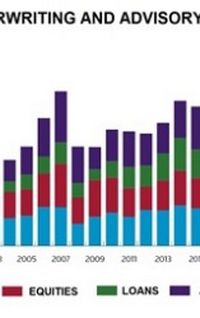As Japanese fund managers broaden their search for yield, international issuers are finding they no longer need to spend the time and money to prepare local language documentation. Old habits die hard, however, and lengthy marketing periods are still standard practice.
![]()
There is a term in Japanese business circles for a market that has developed without the influence of external forces. Garapagosu-ka, which translates to Galapagosisation, takes its inspiration from the quirks of nature found only in the remote Galapagos islands, 1,000km off the coast of Ecuador.
It is a fitting description for the yen bond market, which has retained its own unique characteristics even as the global markets have evolved to become faster and more efficient.
This fondness for isolation, however, is slowly fading. After six years of monetary easing that has dragged government bond yields well below zero, Japanese investors are scouring the globe for higher returns.
The vast yen bond market is gradually embracing international influences, too.
Foreign issuers have introduced the pot system to the yen market, leading a shift away from the retention system that has been a characteristic of bookbuilding in Japan for as long as underwriting syndicates have existed. The pot, where the lead managers run a single order book, encourages transparency and promotes accountability, minimising the risk of rival underwriters competing with each other to sell their individual portions. Issuers argue the process delivers the best possible price for their debt, and it has been the dominant bookbuilding strategy in the global markets for 20 years.
The first Samurai bond to use the pot system was a three-tranche financing for South Korea's Shinhan Bank in October 2017, when the issuer and its advisers were looking for greater efficiency amid worries about geopolitical risk in the Korean peninsula. The idea caught on surprisingly quickly, and all international yen issues in the following years have followed the pot system.
However, the traditional retention system still lives on in Japan’s domestic market, where the big investors remain extremely secretive and bankers resist any calls to share information with their rivals.
The pot system has gained some traction on hybrid bonds, as the characteristics of such fundraisings are similar to equity offerings, where large shareholders are made public. As such, it is easier to convince issuers and investors that the pot system is preferred.
Some small green bonds have also been sold using the pot system, but it was not until May 2018 that the pot system was used for the first time on a major domestic straight bond – Fast Retailing’s ¥340bn four-tranche offering.
FORMATS
Japanese investors have also broadened their horizons in terms of issuance format, with the result that foreign issuers no longer need to spend the time and money to prepare local language documentation before selling bonds in Japan.
The traditional Samurai format, where bonds are issued under the Japanese law and are included in the Nomura BPI, Japan's major bond index, is still the preferred choice for most Japanese money managers. Increasingly, however, the big savings banks, insurance funds and asset managers are accepting yen bonds issued off EMTN programmes and SEC-registered platforms, as they learned they would miss out on investment opportunities if they limit their options.
The Bank of Japan's ultra-low rates and massive bond buying programme also squeezed local returns, sending investors into foreign currencies in search for yield, where EMTN programmes and SEC-registration are common.
The first wave of euroyen and global yen issuance came in 2017, when global names such as Starbucks and Walmart tapped the yen market in search of cheap funding. The second push came in early 2019, as global banks rushed to sell yen bonds to raise funds for their total loss-absorbing capacity requirements. The first quarter of this year was also the final three months before the Japanese Financial Services Agency increased the risk-weighting on TLAC investments for some Japanese regional investors.
TLAC issuers – by nature some of the world’s most sophisticated financial institutions – chose the euroyen format to avoid the lengthy documentation process that comes with a Samurai offering, and were able to convince Japanese investors to accept the format in order not to miss the investment opportunities before the risk weightings were raised.
BNP Paribas, Societe Generale, Credit Agricole and Bank of America all used the euroyen format in early 2019. Even Rabobank and BPCE, both frequent Samurai issuers past and present, also chose the euroyen format to snap up demand. Barclays, too, sold TLAC in a euroyen private placement in the final week of March, illustrating how much more accommodating the yen market has become for top foreign issuers.
STILL HIGH HURDLE
Despite these issuer-friendly developments in the yen market, foreign borrowers are still left exposed to a substantial amount of market risk due to Japan’s unusually long bookbuiding periods. Even though yen yields remain relatively stable, overseas issuers have to reckon with a swap market that is susceptible to changes in currencies and global interest rates.
Japanese bankers, especially those who are dealing with international yen deals, are well aware of the challenge this creates.
"I always tell my staff to shorten the marketing period as much as possible," said Masaya Mizobuchi, head of global debt capital markets at Mizuho Securities.
Some international issuers have been able to shorten the process. The Republic of Indonesia in May, for example, priced ¥177bn of six-part Samurai bonds after three days of marketing, down from four days when it came to the market last year. French bank BFCM, now a regular issuer of senior Samurai bonds every October, was able to price after a one-day sounding and two-day marketing period, as opposed to usual two and three days for a Samurai issue.
Still, those windows remain long compared to global standards. Indonesia now routinely announces and sells bonds within 24 hours, most recently pricing US$1bn of 30-year bonds and €1bn of 12-year bonds on October 23. In yen, many foreign issuers still need three or even four days to market a new issue.
LENGTHY BOOKBUILDING
The lengthy execution process for international yen deals is a reflection of customs in the domestic market, where marketing periods can stretch into the absurd.
Takeda Pharmaceutical spent three months from mid-February to sound out investors for its 60-year non-call five-year hybrid, followed by two days for a process called "soft-hearing". It officially started marketing on May 17 and priced on May 31. Such a long process may have helped reach the issuer's ambitious target of ¥500bn, but is far from the only example.
In September, Nippon Steel and Daiwa House Industry both priced hybrid bonds after marketing the offerings for more than a month. Nippon Steel started sounding out investors for a three-tranche 60-year hybrid, callable after five, seven and 10 years, from August 5 to August 22 followed by a day of soft-hearing. Marketing officially started on August 24. Although the guidance ranges were finalised on September 3, the issuer had to wait until September 6 for pricing. Daiwa House started talking to investors on August 8, but priced its ¥150bn issue – split between a 35-year non-call five, 37-year non-call seven, and 40-year non-call 10 – on September 18.
For municipal bonds, the bookbuilding process is a lot shorter, but even there it is questionable whether the days-long marketing exercise delivers any benefit as the bonds often price at identical levels.
In October, for example, four municipal governments sold five-year muni bonds at an identical 0.001% yield. Aichi Prefecture and City of Kobe priced on October 2, followed by Hyogo Prefecture five days later, and Tokyo Metropolitan Government on October 18.
All four started marketing with guidance at 0.001%, without trying to test pricing parameters, but still took at least two days to confirm price. Tokyo took three days to raise only ¥5bn from a green bond, an increasingly popular product among buy-side market participants.
JAPANESE CULTURE
Some attribute the lengthy marketing to Japanese culture.
"The notion still firmly exists in Japan that the longer an issuer spends for marketing the more thoroughly it communicates with investors," said a Japanese banker. "Issuers probably believe so because that’s what their bankers tell them."
Several bankers blame the lengthy procedures on Japanese investors’ need to get internal approvals. The internal approval system is very typical of the decision-making process in Japan.
"We often hear from regional investors that they need more time before placing orders, especially for foreign credits," said a second banker.
Bankers stress they need to do more to educate Japanese market participants about the importance of global standards in order to attract more international issuers and help Japanese investors satisfy their quest for yield.
"The [international] yen market cannot grow without supply," said Hiroyuki Kinoshita, head of global fixed income capital markets at SMBC Nikko.
The first banker said, however, that it is not necessarily correct to blame Japanese regional investors. "They do place orders in time for benchmark-size deals priced in London," he said.
This year's landmark ¥430bn six-tranche transaction from Berkshire Hathaway is a case in point, providing a hint on how the process can be shortened. Despite the global format, the US conglomerate gave investors ample time for credit work by making the mandate announcement two weeks earlier.
“We may be able to shorten the marketing period by making a mandate announcement well in advance or by doing a non-deal roadshow,” said a third banker.
Berkshire’s massive deal at least showed that the yen market is firmly on the map for global issuers, despite all of its local quirks. Evolution, however, has to come from within.
To see the digital version of this report, please click here
To purchase printed copies or a PDF of this report, please email gloria.balbastro@refinitiv.com
















